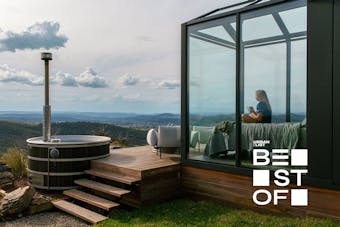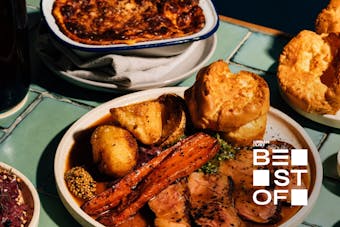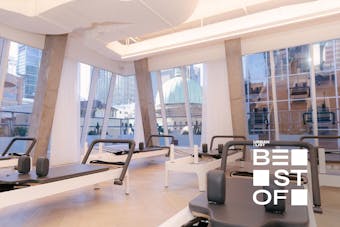Trending
The Best Restaurants In Sydney In 2025
This is Urban List's guide to Sydney's best restaurants for June 2025, curated by our expert food editors and food-obsessed content creators.
What’s On In Sydney This Week, This Month And Beyond
Your guide to what's happening in Sydney this week, the rest of June, and beyond.
19 Amazing Tiny Homes In NSW For Your Next Off-Grid Getaway
NSW is speckled with tiny houses for an off-the-grid getaway.
The Latest
How Keely Bradley’s Love Of Secondhand Fashion Has Coloured Her Life
Expert colour combinations, chronic illness and an ingrained love for anything vintage.
Where To Warm Up With The Best Sunday Roasts In Sydney
From classic pub plates to fancier restaurant versions, we've found Sydney's most impressive roasts, complete with enormous Yorkshire puddings and all the trimmings.
Bondi Festival Is Returning With Its Iconic Beachside Ferris Wheel This Winter
The wintry arts festival is bringing comedy, theatre, live tunes and ice skating to the beach.
Coming Soon: Homer Rogue Taverna
From the brothers behind local legend Ham Cafe in Cronulla comes Homer Rogue Taverna—an gritty, graffiti streaked Greek restaurant plating up a plethora of meats, seafood, vegetables, and traditional woodfired flatbread.
Felons Seafood
Felons Seafood is a dining room and bar from Felons Brewing Co. opening in Manly in late June, 2025.
Argyle House Is The Newest Addition To The Southern Sydney Dining Scene
Argyle House is Camden’s newest hospitality venue, showcasing multiple dining areas, rooftop domes, and a menu that embraces Camden’s evolving food culture.
Korean Restaurant Hongdae Pocha Is Doing Seoul Streetfood And Soju In Chippendale
Opening on Friday 27 June, 2025, Hongdae Pocha is a ode to Korea's nightlife and its pocha dining scene.
The Best Things To Do In Sydney This Weekend
Your guide to the best things to do in Sydney this weekend.
Saint Haven Bondi Beach
Ultra-luxury private club and wellness centre Saint Haven is making the move to Sydney.
Hideout Cabins
90 minutes south of Sydney, Hideout’s three tiny homes provide a peaceful Southern Highlands escape set on a 140-acre working farm.
Buttered Sydney
Buttered is a Sydney bakery and cafe offering a selection of much-loved Korean pastries and top-notch drinks.
Sick Of Winter? Here’s How To Score $1,000 Towards Your Next Holiday
The voucher can be used for staycays in your hometown, relaxing retreats in South East Asia or an all-out Euro summer.
We Asked Our Team for Their Favourite Lazy Dinner Hacks
Sometimes the best meals are the ones that take the least effort—here are our team's faves.
The Best Hotels In Singapore Worth Booking In 2025
Looking for where to stay in Singapore? From luxe stays to budget-friendly gems, here’s our ultimate guide to the best hotels in Singapore for 2025.
Butter
Surry Hills has a new kid on the block with Butter bringing fried chicken, bubbly, old-school urban beats and fresh kicks to our fair city.
Escape Bathhouse
From the crew behind the award-winning glamping retreat, Sierra Escape Mudgee, Escape Bathhouse is a wellness sanctuary landing on Sydney’s North Shore in Spring 2025.
Izy.AKI
Izy.AKI is a Sydney omakase restaurant prioritising seasonal ingredients and a theatrical flair.
Cruise Bar
Iconic Sydney waterfront spot Cruise Bar has had an extensive renovation, giving this harbourside destination a luxury facelift and a complete menu makeover.
Minimalist Matrix Is Trending: Here’s How We Thrifted The Look
Whether it’s Hailey, Kendall, Bella—or the mysterious man serving straight looks outside your local—the minimalist matrix aesthetic is having a moment.
From Classiccore To The New Business Casual: Suss Our Crew’s Trending Op Shop Finds
Meet classiccore—the lover of all things crisp collars and sensible loafers, and the rise of new business casual—less blazer, more personality.
12 Of The Most Beautiful Road Trips In Tasmania
Every route is a scenic route when road tripping through Tasmania, so there’s a lot to get excited about. So pack your bags and embark on the adventure of a lifetime with these 10 stunning road trips to take in Tasmania.
Chalky’s
From the team behind Bucketty’s Brewing Co, Chalky’s is the Northern Beaches’ first dedicated pool hall, with karaoke, a sports bar and a cocktail den.
Tqm.
Tequila Mockingbird has had a makeover, returning as tqm., a sunny South American eatery with a Michelin-rated Venezuelan chef bringing theatre and soul to the table.
Herbs Taverne
Herbs Taverne is a popcorn-fuelled, psychedelic negroni playground in Sydney's CBD from the team behind Bar Planet, Cantina OK!, Centro 86 and Tio’s.
Soak Bathhouse Alexandria
Soak Bathhouse's first Sydney location is a 700-square-metre wellness hub with several pools, spas, saunas and more.
What’s On In Auckland This Week, This Month And This Year 2025
Auckland is pulling out all the stops this month. Here’s what’s on in Auckland this week, this month, and this year.
Heading To Noosa? Add These Stunning Spots To Your Stay And Play Lists
With a forecast of crisp sunny days and good times on the agenda, there’s endless places to play and stay in this literal slice of paradise.
6 Of Sydney’s Most Iconic Venues And Why You Should Visit Them
Beachfront dining, harbour views and pure wow factor: Sydney has it all when it comes to iconic dining spots.
The Norfolk
The Norfolk champions local Redfern businesses with an old-school Aussie menu in the front, and Ricos Tacos in the courtyard.
Bar Freda’s
Bar Freda’s is back in Chippendale, with a two-storey site, frozen cocktails, and lasagne croquettes.
Australia Street Suites
Australia Street Suites is a boutique hotel and luxury foodie escape in Sydney's Inner West.
R by Raita Noda
R by Raita Noda blends authenticity with Japanese theatrics in this modern omakase spot set in Redfern's Wunderlich Lane precinct.
The Best Florists And Flower Delivery In Sydney Right Now
Nothing hits quite the same as receiving a bunch of flowers—even when you've bought them yourself.
50 Of The Best Things To Do In Sydney In 2025
Here it is folks, your dedicated guide to the best things to do in Sydney.
Brush Up Your General Knowledge: We’re Throwing A Trivia Night At The Cronulla RSL
If you’ve got an encyclopedic knowledge of everything from pop culture to world history, clear your calendar on Wednesday 9 July—because we're throwing the ultimate trivia night, and you’re invited.
40Res
40Res does fine-dining dishes and boutique wines in a relaxed and fluff-free setting in Surry Hills.
Osteria Mucca
Osteria Mucca is an old-school Italian restaurant set in a former butchery shop in Newtown's Australia Street precinct.
Kolkata Social
Ditch butter chicken and naan for treasured Bengali family recipes at Kolkata Social—a Newtown Indian restaurant by former Firedoor and Raja chef Ahana Dutt.
San San
San San is a creative sandwich bar in Revesby doing a modern take on the classic deli.
This Cosy Christmas Festival Is Returning With Mulled Wine And A Fireside Cinema In July
Round up the crew because Christmas in July Festival is back, bringing a decadent slice of European Christmas down under.
Luxury Escapes Just Announced Limited-Time Deals For These Top Destinations
Whether you're looking for a beachside vacation in Southeast Asia or you want to see what delights Australia has to offer, here's how you can experience a luxury vacation without breaking the bank..
The Best Spots To Watch The Sunset In Sydney
Here's where (and when) to watch a magical sunset in Sydney.
The Grumpy Baker & Bar
Sydney institution The Grumpy Baker now delivers a bakery by day, bar by night in inner Sydney’s charming Potts Point.
Rosa
Rosa is Pyrmont’s Amalfi-inspired neighbourhood pasta bar, where you can indulge in authentic Italian dishes–all under $30.
Cibaria
Cibaria at Manly Pacific Hotel is a modern, beachfront Italian eatery from Sydney restaurateurs Alessandro and Anna Pavoni.
This Winter Festival Is Bringing Real Snow And A Toboggan Slide To Sydney
Sydney is no longer a snow-less city this winter, with Greenwood Hotel hosting 10 days of winter wonderland fun from Friday 27 June until Sunday 6 July.
10 Top-Rated Narooma Airbnbs To Book For A South Coast Holiday
A charming beach town known as the heart of the South Coast's oyster scene, Narooma is an idyllic destination for a holiday.
25 Of The Best Surry Hills Restaurants Right Now
Surry Hills is an action-packed suburb with an abundance of epic, diverse restaurants.
Flora
Flora is a charming and innovative vegetarian restaurant in Newtown's Australia Street precinct.
Baptist Street Rec. Club
Baptist Street Rec. Club is a retro Redfern bar taking inspo from ‘80s and ‘90s Australiana. It’s in the Wunderlich Lane lifestyle precinct, upstairs from House Made Hospitality sibling venue Island Radio—there’s even a secret staircase between them.
Eleven Barrack
Eleven Barrack is a Sydney CBD restaurant blending an old-world steak and seafood grill concept with a stylish setting and service.
Sydney’s Best Pilates Studios To Stretch And Sweat In
The right studio will have you falling in love with the practice of Pilates in no time.
17 Of The Best Airbnbs With Fireplaces In NSW
From roaring fires in living rooms to outdoor firepits perfect for toasting marshmallows, these NSW Airbnbs are as cosy as they get.
18 Of The Best Farm Stays In NSW To Book For A Country Escape
Escape the hustle and bustle with a farm stay in NSW.
Mister Grotto
Mister Grotto is an intimate seafood restaurant in Newtown's Australia Street precinct.
Fat Pomelo
Fat Pomelo is a buzzing Asian fusion diner across from Narrabeen Beach with a gorgeous dining room, bold share-style menu and vibrant drinks.
The Grand National Hotel By Saint Peter
The Grand National Hotel by Saint Peter is a 14-room boutique hotel above the world-respected Saint Peter seafood restaurant.
Lottie
Lottie is a stunning Mexican restaurant and mezcaleria in Redfern’s Wunderlich Lane.
Lock In A Weekend Of Coastal Walks, Poolside Hangs And Epic Discounts At This Gold Coast Hotel
What makes a vacay even sweeter? A tasty discount at one of the country’s most epic hotels, Dorsett Gold Coast.
20 Of The Best Restaurants In Manly Right Now
A beachside paradise with a vibe that's distinct from the rest of Sydney, Manly's restaurants with waterfront views and kid-friendly menus really step up to the plate.
The Best Glamping Spots Near Sydney For A Weekend Away
Think sweeping vistas, bubble tents under the night sky, waterfront views and giant free-standing baths.
Ruma
Ruma is a Double Bay all-day eatery serving modern Australian comfort dishes spiked with exciting Pan-Asian flavours like caviar-crowned Korean fried chicken and kimchi hashbrowns.
Golden Century At Crown Sydney
Sydney's iconic Chinese restaurant, Golden Century, is back.
Letra House
Letra House is an underground wine bar and restaurant in the Sydney CBD tucked beneath Italian eatery Palazzo Salato.


.png?auto=format,compress&fit=crop&w=520&ar=3:2)




.png?auto=format,compress&w=340&fit=crop&ar=3:2)


.png?auto=format,compress&w=340&fit=crop&ar=3:2)









.png?auto=format,compress&w=340&fit=crop&ar=3:2)





.png?auto=format,compress&w=340&fit=crop&ar=3:2)
.png?auto=format,compress&w=340&fit=crop&ar=3:2)









.png?auto=format,compress&w=340&fit=crop&ar=3:2)
.png?auto=format,compress&w=340&fit=crop&ar=3:2)

.png?auto=format,compress&w=340&fit=crop&ar=3:2)





























.png?auto=format,compress&w=340&fit=crop&ar=3:2)





